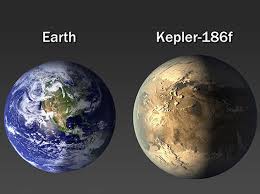New extrasolar planet of similar size to Earth
Wednesday, April 23rd, 2014 2:40:26 by Kashif Mirza
The planet Kepler- 186f is slightly larger than Earth and is in what is called habitable zone, ie, at a distance from a star where water would evaporate and not be frozen. Scientists point out that, theoretically, there could have liquid water on the surface. It is about 500 light years from Earth and is the outermost of the five planets that revolve around a colder dwarf star is Sol ” We only know that they are in a habitable zone and you could far more easily imagine someone being able to go there and walk around on the surface, “says astronomer Stephen Kane, State University of San Francisco. He is part of the team, led by Elisa Quintana (NASA astronomer), who has discovered Kepler- 186f with the data obtained by the Kepler telescope. Researchers have been able to determine the size of Kepler- 186f (1.1 terrestrial radio), but still do not know its mass, so it can not calculate its density. ” Once you know the average density of a planet, you can say if rocky or not,” Kane added. The discovery is published in the journal Science.
Kepler- 186f is near the outer limit of what would be the habitable zone around the star Kepler -186 (in Cygnus), so that water on its surface would risk freezing, but as something more the Earth, maybe have a little more dense than that of our planet and more thermally insulating protective atmosphere.
The star around which revolves the sun is different: smaller, cooler, consume their fuel more slowly and its light is too weak to be observable to the naked eye from Earth. The stars of this type, Kane said in a statement at the university, are abundant in the galaxy and, in principle, be promising from the point of view of looking for life around, because they last much more than large, “which considerably lengthen the period of time in which biological evolution and biochemical reactions on the surface could arise, “adds the researcher. But on the other hand, these stars have to be more active than ours, with more flashes and potentially emit more radiation to the planets. Kepler f -186 makes a complete circle around the star in 13th Earth days and its star recebe a third of the energy the Earth receives from the Sun
” One of the most interesting questions of science is if life can arise on another planet, or the opposite: if something unique of our own. The discovery of planets with similar properties to those of the tierral is an important link in the chain is needed to answer this question, “says Fred Adams (University of Michigan), computer scientist.
In their hunt for Earth-like planets, astronomers have discovered some that, for some features, would fit the pattern, summarizes Yudhijit Bhattacharjje in Science. Kepler 20e is slightly smaller than Earth and revolves around a sun-like star, but outside of the habitable zone (would be too close to the star and therefore would be too hot); Kepler- 22b is orbiting a star like ours and habitable zone, but is larger than the Earth (2.4 times its radius); and now f -186 Kepler, whose size is fit and habitable area, but the star is not like the sun in the last two decades, since the first was discovered, astronomers have found about 1,800 extrasolar planets in other planetary systems. Only 20 of them orbiting its star ‘s habitable zone, remember the University of Michigan. But they were all so far, much larger than Earth.
The other four co- Kepler -186 f around the dwarf star bodies are less than half the size of Earth and orbits its last three, seven, 14 and 22 days respectively. They’re too hot and inhospitable to a way of life as we know it, they explain researchers at NASA Ames and the SETI Institute, which works Quintana.
The planet Kepler- 186f has been discovered with the transit method, ie measuring very slight dimming of a star as a body in orbit around it crosses the line of sight from Earth. After being detected with the Kepler space telescope, NASA scientists turned to large telescopes (the Keck II and Gemini) in Hawaii to confirm the finding and reveal some of its features.
Short URL: https://www.newspakistan.pk/?p=43084

















